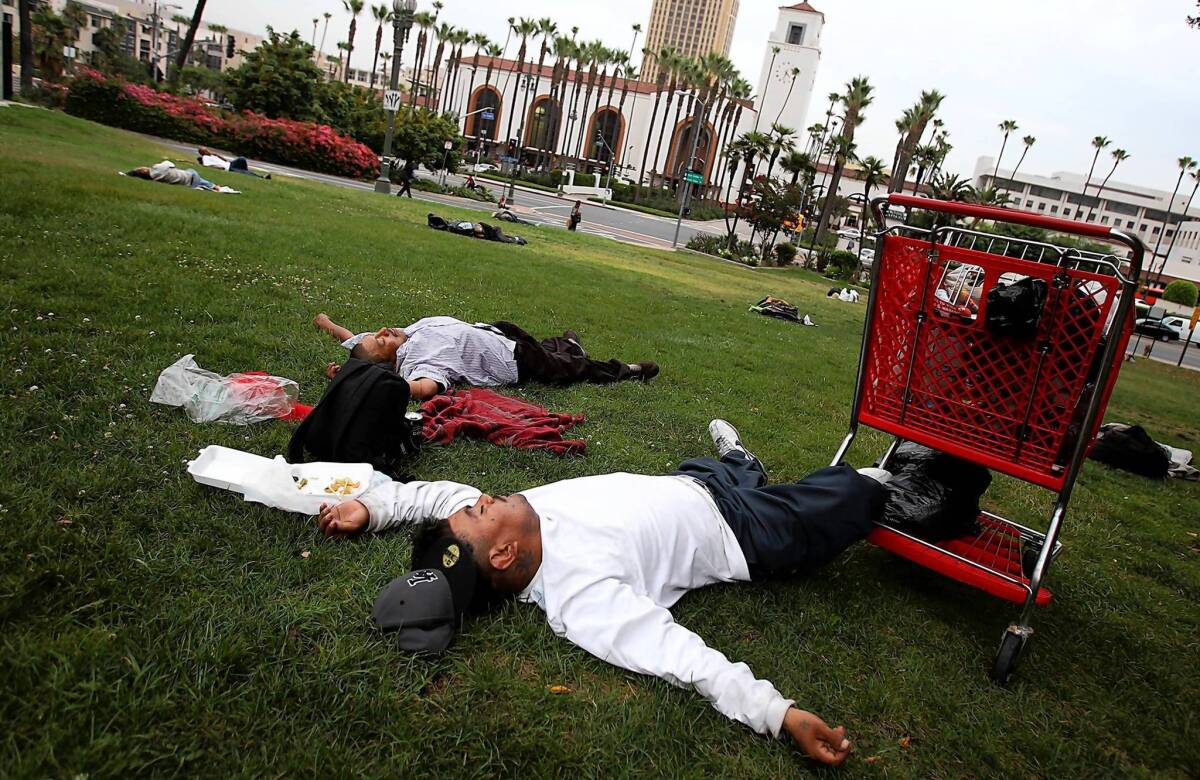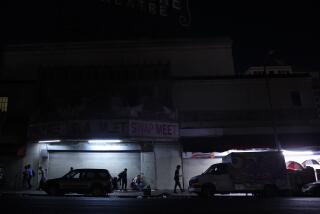L.A.âs urban parks: for the homeless too?

Dawn was breaking when three scruffy men in dark clothing trudged past Grand Parkâs bubble-gum-pink benches and into its purple-tiled bathrooms to wash up.
The early-morning ablutions have become a daily ritual for homeless men at the 1-year-old park across the street from Los Angeles City Hall. But their presence has done little to dim the appeal of the $56-million, county-owned venue, as office workers, loft-dwelling professionals, curious suburbanites and, yes, the homeless flock to evening concerts, public ceremonies, fireworks shows and farmersâ markets.
âI went to the opera the other night,â said Tom Hackett, 60, a former garbage collector from upstate New York and one of the regulars at the homeless bathroom lineup. âIâve never been to an opera.â
The situation isnât so harmonious in other downtown parks, however, as officialsâ efforts to make the facilities more welcoming to the new urbanites have spurred claims of harassment by skid row advocates.
These efforts have also led to homeless nudged out of one park simply relocating to others blocks away â a reminder that even as much of downtown crackles with new, upscale condos, bars, restaurants and stores, the central cityâs revival still depends on maintaining an uneasy truce with one of the nationâs largest concentrations of people living in the streets.
âItâs a game of cat and mouse,â said UCLA law professor Gary Blasi, who has studied homelessness in Los Angeles, âexcept the mice have nowhere to go.â
In the last year, the city and county have opened or planned several new public spaces, including Grand Park, Spring Street Park, an Arts District park and a parcel next to Grand Park to be developed and managed by the city. They join parks that have welcomed visitors for many decades, including Pershing Square, the grassy grounds of City Hall and the historic sites near Olvera Street that mark the cityâs founding.
Park managers at Spring Street and Grand Park included extensive regulations and design elements to discourage homeless people from camping out. Grand Parkâs open spaces, stretching 12 acres from Bunker Hill to the foot of City Hall, in the shadow of the criminal court building, offer few hiding places for prostitutes or drug users. Itâs also farther away from skid row than some other parks, keeping the homeless count comparatively low.
But five blocks south, a resident describes Pershing Square, the cityâs original central park, as a âday-care centerâ for homeless people. The city is trying to change the parkâs character with a whirlwind of movies, concert series and farmersâ markets.
âThe homeless need somewhere to sit and be,â said Kevin Regan, a park administrator. âWe just arenât going to let them live there.â
Skid row activists call it harassment.
A Los Angeles Community Action Network activist known as General Dogon leads a weekly patrol at Pershing Square and other downtown parks to monitor what he says is widespread intimidation of the poor and homeless.
Dogon pointed out concrete seating in the shade that had been cordoned off with yellow police tape. A chain blocked access to the lawn. Restrooms in the underground garage are off-limits to anyone without a parking ticket, and cafe tables with umbrellas where homeless people once rested are hauled out only for the noon concerts and other activities.
Police patrol cars park, sometimes two abreast, on the concrete plaza around the fountain, and officers stop people for loitering, Dogon said.
âHow do you loiter in a park?â Dogon said.
Park officials said the seating is tied off for cleaning or so farmers can store their crates during market days. The grass is off-limits to protect the sound system or to prepare for concerts.
Police and city officials deny any bullying campaign, saying their enforcement efforts are directed at illegal activities.
âWe welcome anybody from anywhere into any of our parks,â said Rick Coca, spokesman for Councilman Jose Huizar.
âThe key is keeping the area in a way that can be used by all,â said Los Angeles police Capt. Horace Frank, who heads the downtown detail.
Police stepped up their presence at Pershing Square last year in response to complaints after Occupy Los Angeles was forcibly ejected from the City Hall lawn, Frank said. Remnants of the group disrupted the farmersâ market, urinating on walls, grabbing food samples and demanding spare change, the market manager said.
As Occupiers drifted away from Pershing Square, a rowdy encampment arose outside El Pueblo de Los Angeles Historical Monument, home to Olvera Street and the site of the cityâs founding. People partied to all hours and tossed needles over the wall into La Plaza de Cultura y Artes â a museum focused on the contributions of Mexican Americans in Southern California â said Father Richard Estrada, the parish priest at nearby La Placita church.
âIt was like a tent city all day long,â he said.
A city-county task force was formed to clean up the encampment, and some of the tarp-covered shopping carts and tents can now be seen at Father Serra Park, across the street from Union Station.
Climbing out of a tour bus with his family, Berlin tourist Nico Gruenberger looked askance at the huddle in Serra Park, with their plush blankets and carts bristling with plastic bags.
âIn Germany we have homeless people, but [this is] a historical part of the city,â Gruenberger said. âHere, unfortunately, everything is together.â
Frank said people have complained about the homeless camp at Serra Park, but other âpeople put out a blanket, so do they. All you can do is shift them around.â
The newest downtown green space, Spring Street Park, opened in June between 4th and 5th streets. The sign at the entrance lists 12 rules, including a ban on shopping carts. Its metal perforated benches discourage lying down, and there are no little enclosed âalcoves,â said downtown neighborhood council President Patti Berman. So far, the only open conflict has been over loose dogs, she said.
But at less than two-thirds of an acre, including a playground, the small park needs to be watched closely to make sure everyone is comfortable and safe, Berman said. She heads a nonprofit that is raising private money to pay for a full-time city ranger to patrol the park.
Not long after Spring Street Park opened, a security guard at the loft building next door called police to investigate two men suspected of cooking heroin purchased on skid row. Zach Calig, a television writer, came down from his condo to find his cousin, whom he hadnât seen for years, slumped on the ground in handcuffs.
Calig said he is in recovery from substance abuse himself and understands how people end up addicted and homeless. But he doesnât want them overrunning his neighborhood park.
âWe donât want it to be Pershing Square,â he said. âWe want it to be Grand Avenue park.â
More to Read
Sign up for Essential California
The most important California stories and recommendations in your inbox every morning.
You may occasionally receive promotional content from the Los Angeles Times.










